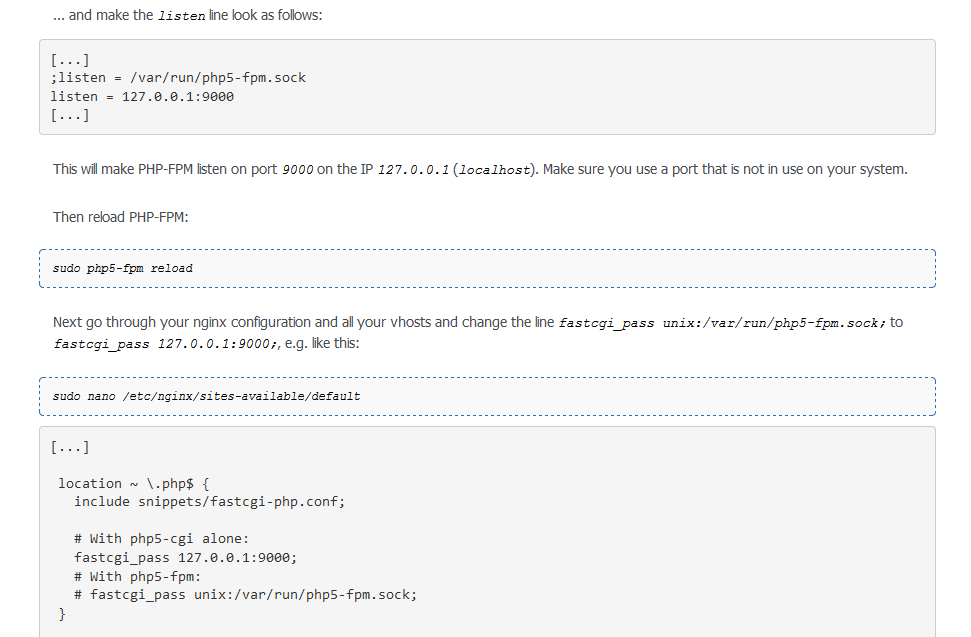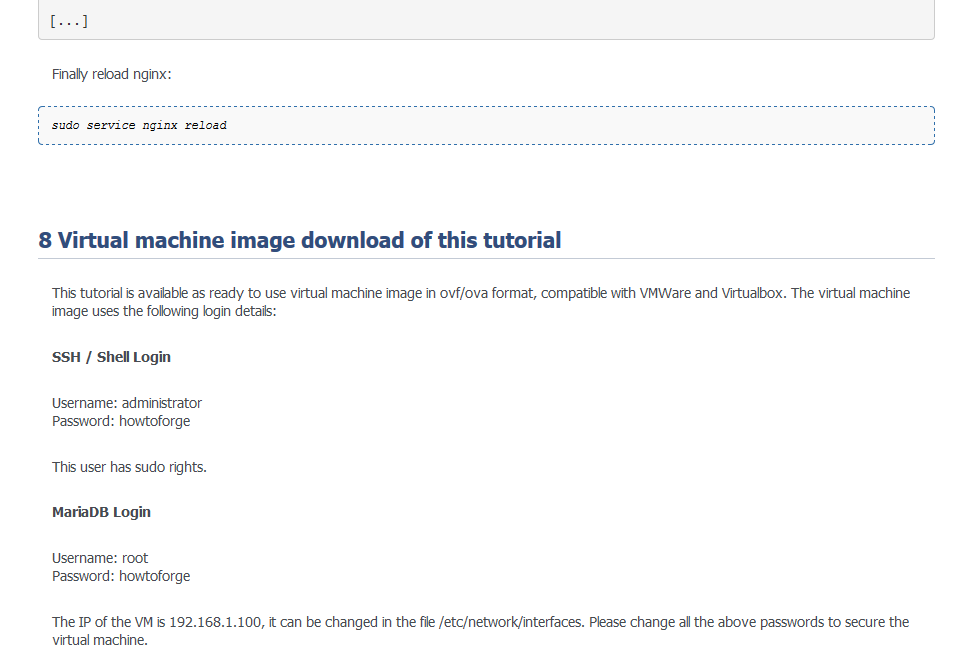1.
How To Install Linux & Nginx & MySQL & PHP (LEMP) stack on Raspberry Pi 3
Raspberry Pi 3,LEMP,Linux,Nginx,PHP(PHP-FPM), MySQL(MariaDB)
Nginx (pronounced "Engine x") is a free, open-source, high-performance HTTP server.
Nginx is known for its stability, rich feature set, simple configuration, and low resource consumption.
This tutorial shows how you can install Nginx on an Ubuntu 14.04 server with PHP5 support (through PHP-FPM) and MySQL support (LEMP = Linux + Nginx (pronounced "Engine x") + MySQL + PHP) .
What’s a LEMP stack?
LEMP is a variation of the ubiquitous LAMP stack used for developing and deploying web applications. Traditionally, LAMP consists of Linux, Apache, MySQL, and PHP. Due to its modular nature, the components can easily be swapped out. With LEMP, Apache is replaced with the lightweight yet powerful Nginx.
Why LEMP instead of LNMP?
We go with LEMP due to the pronunciation for Nginx: Engine-X (en-juhn-ecks). Think of how in English, the article an is used instead of a for hour even though it begins with a consonant. The importance is the sound of the first letter rather than its written representation. Besides, LEMP is actually pronounceable and doesn’t sound like reciting the alphabet.
1
https://www.howtoforge.com/installing-nginx-with-php5-fpm-and-mysql-on-ubuntu-14.04-lts-lemp
Installing Nginx With PHP5 (And PHP-FPM) And MySQL Support (LEMP)
On Ubuntu 14.04 LTS
https://www.howtoforge.com/tutorial/installing-nginx-with-php-and-mysql-on-ubuntu-lemp/
Installing Nginx with PHP and MariaDB (as MySQL replacement) - LEMP
on Ubuntu 15.10 (Wiley Werewolf)
Links
- nginx: http://nginx.net/
- nginx Wiki: http://wiki.codemongers.com/Main
- PHP: http://www.php.net/
- PHP-FPM: http://php-fpm.org/
- MySQL: http://www.mysql.com/
- Ubuntu: http://www.ubuntu.com/
1
1

1

1

1
1
1
1
1
1
1 . PHP FastCGI Example
https://www.nginx.com/resources/wiki/start/topics/examples/phpfcgi/
This example is for newer PHP (>= 5.3.3) using the included PHP FPM (FastCGI Process Manager).
This guide assume PHP FPM already installed and configured either using tcp port (
127.0.0.1:9000) or unix socket (/var/run/php-fpm.sock).There are many guide about configuring NGINX with PHP FPM, but many of them are incomplete (doesn’t handle PATH_INFO correctly) or contain security issues (doesn’t check whether the script is indeed php file).
FastCGI Params
First thing, I recommend keeping all your typical FCGI settings in a single file and importing them.
For example on debian and ubuntu by default there is
/etc/nginx/fastcgi_paramsfile that should looks like this:fastcgi_param QUERY_STRING $query_string; fastcgi_param REQUEST_METHOD $request_method; fastcgi_param CONTENT_TYPE $content_type; fastcgi_param CONTENT_LENGTH $content_length; fastcgi_param SCRIPT_FILENAME $document_root$fastcgi_script_name; fastcgi_param SCRIPT_NAME $fastcgi_script_name; fastcgi_param PATH_INFO $fastcgi_path_info; fastcgi_param PATH_TRANSLATED $document_root$fastcgi_path_info; fastcgi_param REQUEST_URI $request_uri; fastcgi_param DOCUMENT_URI $document_uri; fastcgi_param DOCUMENT_ROOT $document_root; fastcgi_param SERVER_PROTOCOL $server_protocol; fastcgi_param GATEWAY_INTERFACE CGI/1.1; fastcgi_param SERVER_SOFTWARE nginx/$nginx_version; fastcgi_param REMOTE_ADDR $remote_addr; fastcgi_param REMOTE_PORT $remote_port; fastcgi_param SERVER_ADDR $server_addr; fastcgi_param SERVER_PORT $server_port; fastcgi_param SERVER_NAME $server_name; fastcgi_param HTTPS $https; # PHP only, required if PHP was built with --enable-force-cgi-redirect fastcgi_param REDIRECT_STATUS 200;Please note if you’re using Ubuntu Precise (12.04), I change
SCRIPT_FILENAMEand addPATH_INFOparams.Connecting NGINX to PHP FPM
Now we must tell NGINX to proxy requests to PHP FPM via the FCGI protocol:
location ~ [^/].php(/|$) { fastcgi_split_path_info ^(.+?.php)(/.*)$; if (!-f $document_root$fastcgi_script_name) { return 404; } fastcgi_pass 127.0.0.1:9000; fastcgi_index index.php; include fastcgi_params; }If you’re using unix socket change
fastcgi_passto:fastcgi_pass unix:/var/run/php5-fpm.sock;Restart NGINX.
Testing
Create
test.phpon NGINX document root containing just:<?php var_export($_SERVER)?>In the browser try to request: # /test.php # /test.php/ # /test.php/foo # /test.php/foo/bar.php # /test.php/foo/bar.php?v=1
Pay attention to the value of REQUEST_URI, SCRIPT_NAME, PATH_INFO and PHP_SELF.
Here’s the correct output for http://lemp.test/test.php/foo/bar.php?v=1
array ( 'USER' => 'www-data', 'HOME' => '/var/www', 'FCGI_ROLE' => 'RESPONDER', 'QUERY_STRING' => 'v=1', 'REQUEST_METHOD' => 'GET', 'CONTENT_TYPE' => '', 'CONTENT_LENGTH' => '', 'SCRIPT_FILENAME' => '/var/www/test.php', 'SCRIPT_NAME' => '/test.php', 'PATH_INFO' => '/foo/bar.php', 'REQUEST_URI' => '/test.php/foo/bar.php?v=1', 'DOCUMENT_URI' => '/test.php/foo/bar.php', 'DOCUMENT_ROOT' => '/var/www', 'SERVER_PROTOCOL' => 'HTTP/1.1', 'GATEWAY_INTERFACE' => 'CGI/1.1', 'SERVER_SOFTWARE' => 'nginx/1.4.0', 'REMOTE_ADDR' => '192.168.56.1', 'REMOTE_PORT' => '44644', 'SERVER_ADDR' => '192.168.56.3', 'SERVER_PORT' => '80', 'SERVER_NAME' => '', 'HTTPS' => '', 'REDIRECT_STATUS' => '200', 'HTTP_HOST' => 'lemp.test', 'HTTP_USER_AGENT' => 'Mozilla/5.0 (X11; Ubuntu; Linux x86_64; rv:20.0) Gecko/20100101 Firefox/20.0', 'HTTP_ACCEPT' => 'text/html,application/xhtml+xml,application/xml;q=0.9,*/*;q=0.8', 'HTTP_ACCEPT_LANGUAGE' => 'en-US,en;q=0.5', 'HTTP_ACCEPT_ENCODING' => 'gzip, deflate', 'HTTP_CONNECTION' => 'keep-alive', 'PHP_SELF' => '/test.php/foo/bar.php', 'REQUEST_TIME' => 1367829847, )Notes
- The location regex capable to handle
PATH_INFOand properly check that the extension indeed .php (not .phps) whether there is PATH_INFO or not.- The
fastcgi_split_path_inforegex capable to correctly handle request like/test.php/foo/blah.phpor/test.php/.- The
iflets NGINX check whether the*.phpdoes indeed exist to prevent NGINX to feeding PHP FPM non php script file (like uploaded image).Some guides recommend to use
try_filesinstead ofif, if you do that, beware of NGINX bug #321. I personally thinkifis more appropriate for this, even If Is Evil agree this is one of the 100% safe thing to useifwith.This guide run fine on php.ini
cgi.fix_pathinfo = 1(the default). Some guide insist to change it tocgi.fix_pathinfo =0but doing that makePHP_SELFvariable broken (not equal toDOCUMENT_URI).
1
1
1
1
1
1
1
1